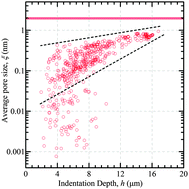Mechanical measurements of heterogeneity and length scale effects in PEG-based hydrogels
Abstract
Colloidal-probe spherical indentation load-relaxation experiments with a probe radius of 3 μm are conducted on poly(ethylene glycol) (PEG) hydrogel materials to quantify their steady-state mechanical properties and time-dependent transport properties via a single experiment. PEG-based hydrogels are shown to be heterogeneous in both morphology and mechanical stiffness at this scale; a linear-harmonic interpolation of hyperelastic Mooney–Rivlin and Boussinesq flat-punch indentation models was used to describe the steady-state response of the hydrogels and determine upper and lower bounds for indentation moduli. Analysis of the transient load-relaxation response during displacement-controlled hold periods provides a means of extracting two time constants τ1 and τ2, where τ1 and τ2 are assigned to the viscoelastic and poroelastic properties, respectively. Large τ2 values at small indentation depths provide evidence of a non-equilibrium state characterized by a phenomenon that restricts poroelastic fluid flow through the material; for larger indentations, the variability in τ2 values decreases and pore sizes estimated from τ2via indentation approach those measured via macroscopic swelling experiments. The contact probe methodology developed here provides a means of assessing hydrogel heterogeneity, including time-dependent mechanical and transport properties, and has potential implications in hydrogel biomedical and engineering applications.


 Please wait while we load your content...
Please wait while we load your content...